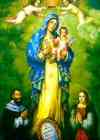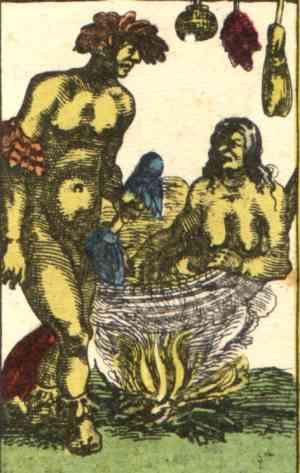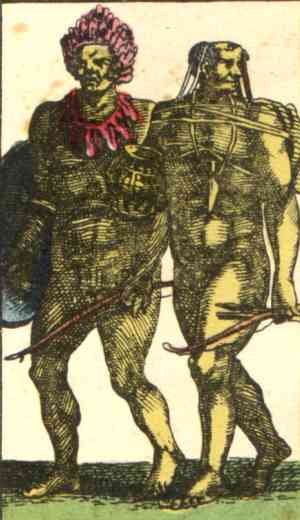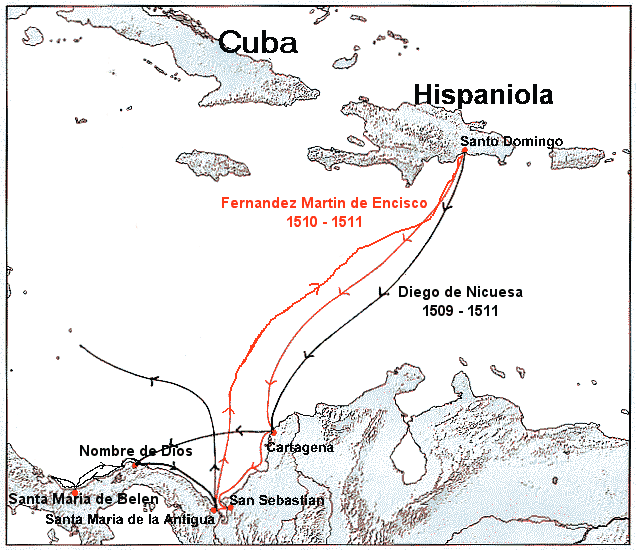|
||
|
When
Columbus returned to Spain in 1504, after his fourth voyage to the New
World, he reported on the rich goldfields in Veragua on the Isthmus.
This earned the name of Castilla
del Oro to the area. All of Tierra Firme, West of the Gulf of Darien, was
named Castilla del Oro, while all of the land to the East was named
Nueva Andalusia, which included the North Coast of South
America.
At
that time, there were two Spaniards interested in colonizing
Tierra Firme. One was Alonso de Ojeda
and the other was Diego de Nicuesa.
Ojeda, lacked the funds to attempt such an enterprise, and joined
forces, while still in Spain, with Juan
de la Cosa, the famous navigator and cartographer, who had been
with Columbus and others, on voyages to the New World, and had
accumulated a small fortune from these exploits.
Not being able to select which explorer to award the charter, he appointed them
both. Nicuesa was given the province of Castilla del Oro, from Cape Gracias a Diós to
the border of Nueva Andalusia. Ojeda was given Nueva Andalusia from Cape
de la Vela to the domains of Nicuesa. The dividing line between these two
provinces was left for them to fight out. In
the fall of 1509, the
two governors met in Española and started quarreling right away. Diego
Colon, the governor of Española, did all he could to hinder the two
governors, and refused to give them ships and men, as ordered by the King.
With the help of Juan de la Cosa, they agreed to make the Darien River, as the boundary between their provinces. Ojeda, still in need of additional funding, was able to enlist the Bachelor of Law (lawyer), Martin Fernandez de Enciso to his enterprise. This astute attorney had amassed a fortune in the few years of practicing law in Española. For his financial support, Ojeda made him, "Alcalde Major" (Chief Justice), of the vice-royalty of Nueva Andalusia. On November 12, 1509, Ojeda set sailed from Española, with two ships, two brigantines, three hundred men and twelve brood mares. Enciso remained in Santo Domingo, recruiting more men and purchasing supplies. He was instructed to sail to Nueva Andalusia and the settlement of San Sebastian with reinforcements, as soon as possible.
|
||
|
Enciso sailed from Española on September 1, 1510 with 2 ships, a caravel and a brigantine,
150 men, 12 mares, some stallions,
pigs to breed, plenty of food and clothes, weapons and 2 stowaways, to join Ojeda.
Once they were far
out to sea, away from Española, the stowaways revealed themselves. Vasco
Nuñez de Balboa and his dog, Leoncico, were hiding in two large
caskets, left his hiding place and
presented himself to Enciso. Balboa had tried to join the
expedition of Ojeda, but was prevented from doing so, because the governor of Española
had passed a law, forbidding any resident, that was indebt, to leave the
island, without first paying off their debt. Since he was still in debt,
he conspired with his friend Bartolomé Hurtado to hid him in a
casket, and put it on board the ship. Enciso, at first, ordered
that Balboa be put in chains; but, Balboa's friends convinced him that
Balboa knew the land where they were going, and was an excellent soldier. Enciso
realized that Balboa had much to offer and allowed him to join the
expedition.
Not wanting to lose his investment in the enterprise, Enciso, the Major Mayor, ordered Pizzaro to turn around, and head back to the Gulf of Urabá or Darien. As they approached the Caribana Point, against the recommendations of Balboa and the pilot, Enciso, sure that he could do noting wrong, ordered the ships to move in close to the point. The caravel on which he was on (and Balboa), hit a reef and started to sink very rapidly. The passengers were able to save themselves with the help of the other two ships, and their row boat. They lost all of the horses, pigs, and most of the provisions, since they were mostly on the caravel. Enciso then continued on to San Sebastián, where they discovered that the settlement had been burned to the ground by the natives. Lacking provision, they had to live off the land, hunting peccary and eating fruits. Wanting to get food from the natives, Enciso, ordered and led his party inland, hoping to capture a native village, and take their food. But the natives were prepared, and attacked the Spaniards as they approached with poison arrows forcing them to retreat. Enciso became very discouraged because they had lost all of their food, clothes and weapons. His settlers were divided in what they wanted to do and were rebelling against him. To resolve the problem, he held a town meeting with all of his men. There options were to either go back to Española in defeat, join the expedition of Diego de Nicuesa that was trying to establish a settlement in Veragua, or remain in San Sebastián and try to rebuild the community. Every man (Spanish, Catholic male) was asked to give his opinion on what they should do. When it came to Balboa's turn, he suggested that they move the settlement to the western side of the gulf. |
||
|
||
|
Vasco Nuñez de Balboa was about 35 years old, when
he directed the Spaniards to their first secure foothold on Tierra Firme
(Continent of America). His
suggestion to try the western shore of the Gulf of Darien was accepted
by acclamation. Enciso saw this option as another way to salvage his
investment in the expedition. Not being able to fit all of the men into
the one remaining brigantine, some of the men were left at San Sebastian,
in a hastily reconstructed stockade for their defense. They then crossed
the gulf, where Balboa directed them to a territory ruled by the Cacique
Cemaco. Cemaco was a man that remembered the problems with the Spaniards the first time they visited his territory. In the Spanish Chronicles of the period, his name appears again and again, for being a thorn in the side of the Spaniards. Remembering the problem with Bastides, and prepared to receive the Spaniards. As soon as he saw the long boats approaching land, he sent the women and children into the jungles to hide. After they were protected, he went to the beach with 500 warriors to meet the invaders. When Enciso landed, he proceeded with the Spanish custom, of proclaiming all of the land for the King of Spain and the Holy Catholic Church.. This ceremony was attended by his notaries, priests, officials, soldiered and some of the sailors. He had a notary read aloud the same proclamation use by Ojeda (and all Spaniards) to the natives. This was the proclamation where he took the land for the King of Spain, and the natives had to abandon the ruler and take the King of Spain, as their new ruler. He then had the priest read another proclamation where he promises to baptize all of the heathens. He promised the Virgin Mary, that this heathen town would be hers in name, if she would make it his in substance, along with Cemaco's gold, he will build on Cemaco's land a church, and dedicate it to her adored image, Antigua of Seville. He also promised, that if she would do that for him, he would take a pilgrimage to her holy shrine. While all of this was going on, more men were disembarking from the ships. This ceremony had the function of legalizing what ever the Spanish did against the natives, who were not Christians. Once all the formalities were dispensed with, the Spaniards yelled their war cry "Santiago" and charged the natives with such ferocity, that they quickly routed them. They chased the fleeing natives to Cemaco's village and captured it. Making good his promise, he re-christened the village, "Santa Maria de la Antigua del Darien". With in the next couple of days, they had consfiscated large quantities of food and over $50,000 in gold from the natives.
|
||
|
Once the Enciso had fortified his position, he sent the brigantine back
to San Sebastian to bring the rest of the settlers. Enciso, being a
lawyer, went about writing new laws and code for governing this land of
gold. To him it was more important to establish the laws and rules by with
the colony would be governed, than to plant crops to feed the community.
of organize work details. Since Ojeda, who was the governor, was not
there, and had abandoned them, or may possibly be dead, they did not know.
Enciso took on the job of the governor, with all of its rights and privileges.
He enacted laws that were designed to rule a civilized city in Spain, not
a small village in the middle of the uncivilized jungle. As acting
governor, he demanded that all booty belonged to him, and the people that
did the fighting, would get a small share. The colonist were not prepared
to lose, to Enciso, by his laws, what they had won by their sweat and
blood.
The settlers became upset with these new laws, and some talked about revolts, arresting Enciso and sending back to Santo Domingo, or killing him, etc. As the rhetoric increased in fervor, and the hostility towards Enciso was at its peak, Vasco Nuñez de Balboa, advised the settlers to calm down, that there were other recourses they could follow. He informed them, that they were now in the province of Castilla del Oro, not Nueva Andalusia. That Castilla del Oro, was the domain of Nicuesa, while Ojeda was the governor of Nueva Andalusia. He reminded them that Ojeda's domain was on the other side of the bay and south of the Darien River. He told them, that Enciso was the Alcalde Mayor in San Sebastian, province of Nueva Andalusia, and Enciso had no legal authority in the new settlement of Antigua. The colonist's attitudes changed when they realized that Enciso had no power in Castilla del Oro, and immediately held elections for new leaders. They elected two Alcaldes (Mayors), Vasco Nuñez de Balboa and Martin Zamudio. Unfortunately for the new community, new leaders did not mean an end to its problems. They still had to build a city, with roads, churches, houses, parks, and fortifications. They had to plant crops so they could feed themselves in the future. Balboa, being a soldier, aligned himself with the soldiers. He was
more interested in military matters, than the civil duties of running the
community. He had remarkable tact
for smoothing out quarrels between the settlers when they arised. He was
very just
in divisions of the spoil insuring that everybody got their share,
whether they took part in the battle, or stayed home taking care of the
crops. And above all, he was tireless in providing
for the comfort of his men. The Spanish historian Oviedo, who always
slandered every act of Balboa, admitted: "No chieftain
who ever went to the Indies equaled him in these respects."
|
||
|
Enciso returned to Spain in 1512 and brought charges against Balboa in the Spanish Court. He was accused of the miss-treatment of Nicuesa and possible cause of his death. He also brought charged against Balboa for his treatment of Enciso. A new governor was appointed for Castilla del Oro in 1514, Pedro Arias de Ávila, aka. Pedrarias. Enciso accompanied Pedrarias back to Antigua, as Alguacil Mayor (Bailiff). Soon after his arrival, he obtained a legal ruling against Balboa, forcing him to pay Enciso a large amount of money, as indemnity for the wrongs that he suffered. In 1515 he was in charge of an expeditionary force into the province of Cenu, where it was reported there was a lot of gold. He tired to persuade the natives to trade for their gold, and was unsuccessfully in this endeavor. Since they would not trade, he tried to take it by force and make the caciques, submit to the king of Spain. He failed miserably in this task also. He knew a lot about the law, but very little about how to lead an army, or military strategy.
|
||
|
|
||
|
Soon after failing as a military commander, he returned to Spain. There he published his "Suma De Geografia Que Trata De Todas Las Partidas Del Mundo", the first account in Spanish of the discoveries in the New World, previously, everything published about the New World was written in Latin. The work was dedicated to the Emperor Charles V and published in Sevilla on 1519 and reprinted in 1530 and in 1549. In this book, he printed all that was know at the time of the art and science of navigation. He went into great detail on explaining about all of the instruments used for navigation, and the mathematic used. He provided great detail on all of the lands that had been discovered, (up to 1519) including the inhabitants, animals and plants. He gives the first description of the avocado. |
||
|
||
|



